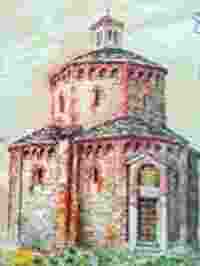Saint Catherine of Siena
 Miracles and healings of St. Catherine of Siena
Miracles and healings of St. Catherine of Siena
They are counted among the Saint's many miracles:
- Miraculous healings of people suffering from various diseases including the bubonic plague has freed several people possessed by the devil.
- He freed several people possessed by the devil.
- Divine visions that gave him several missions.
His confessor, Brother Raimondo da Capua, testifies that many people came to see the Saint; it was enough for her to be there in a fascinating way, without speaking, to convert their souls.
Join Us
Miracles, healings and wonders of Saint Catherine
One of the miracles recognized by the Catholic Church dates back to October 1376, when, returning from the papal court of Avignon, it passed to Varazze (locality of Savona), curious to know the places that had given birth to the blessed Jacopo da Varagine.
Catherine, however, had an unpleasant surprise: the town looked bad and abandoned because of the plague that had decimated the population. Catherine prayed intensely for the inhabitants of Varazze to end their pain and the citizens were freed from the scourge. In exchange for the prodigy, the saint asked the varazzini to honor their illustrious fellow citizen, dedicating a chapel to her name and to the Most Holy Trinity. In memory of that miraculous episode, Varazze elected her the patron saint of Siena to dedicate it each year, on April 30, one of the most famous processions in Italy (followed by a historical parade that traces the deeds).
According to another testimony, of a friar, Francesco Malevolti, who happened to the Rocca at that time, happened one day this episode: A group of men had brought to the Rocca a poor screaming and gebly bound with big ropes on the rump of a mare. They unloaded him in the courtyard of the castle, leaving it all tied up and standing at a certain distance. Catherine, descending into the courtyard with Countess Salimbeni, took a series of shouts and insults shouted loudly from the unfortunate. She ordered the one who had brought it so far to melt it "and do not torture him in that way". On the contrary, he went to him and said, raising his voice in a tone of command: "In the name of Jesus Christ, untie him." And that immediately became meek and lay on the ground at the feet of Catherine. When he was untied, he almost fainted and Catherine ordered, "Now get it up, take it inside and give it something to eat, it's just a great weakness." This was done. The poor man, back in himself, was very surprised to find himself in that place among those people. He did not remember either to have given in escalation, or to have been bound. He was perfectly healed, in short. How, after him, many others. And of these healings there was a long conversation throughout the valley.
Catherine wanted to go to bring peace even among these brothers, as soon as the news of her arrival spread, whole crowds flocked. Raimondo da Capua, who was present, then wrote: "I saw thousands of men and women descend hurriedly from the tops of the mountains, rushing from the surrounding lands, almost responding to the sound of a mysterious trumpet. They came to see her, they did not pretend to speak, her presence was enough to convert the souls and move them to contrition. Everyone cried their sins and approached the sacrament of confession, I witnessed the sincerity of their repentance and it is evident that an extraordinary grace worked in their hearts.
At thirty, Catherine had learned to read the Psalms and here is the miracle as witnessed by Raimondo da Capua. The episode is told by her confessor in the Maior legend. Catherine had told him that she had the gift of knowing how to write after an ecstasy. "So, asleep, I began to write".
Caherine was able to make incredible fasts and once abstained from food for fifty-five days, in the spiritual preparation of a religious festival.
Catherine then when she fell into one of her ecstasies, estranged herself in prayer, she did not feel anything anymore, it was as if she came out of her body that could be beaten up, punctured and even kicked. She did not notice. It happened that they even threw her out of the church, on a pile of stones.
In 1374 the bubonic plague broke out in Siena, the scourge of the disease had transformed Catherine's house into a hospital. Catherine flocked everywhere, day and night ready for every call. Even her confessor at Raimondo da Capua was infected. He himself later tells the events. Describes the symptoms of the disease, then the desperate race, supported by another friar up to the house of Catherine. Catherine was not there, the poor man in the grip of fever and delirium collapses on the floor now certain that he will die. Catherine returned, saw her confessor in that state, threw herself on her knees and prays. She is convinced that only in that way can she help him. Miraculously, Raymond healed and later recounted that he had the sensation of being torn from the body by the bubo and the evil.
A few days later, another Dominican, fray Matteo, rector of the Hospital of Mercy, had the same experience, He contracted the plague, was dying, lying on a bed with his limbs shaken by the high fever and with the bubo in the chest. Catherine goes to her rescue, with faith prayed the Lord for healing. And Fray Matteo gets up healed and goes to bring help to the other plague victims.
 Miracles and healings of St. Catherine of Siena
Miracles and healings of St. Catherine of Siena